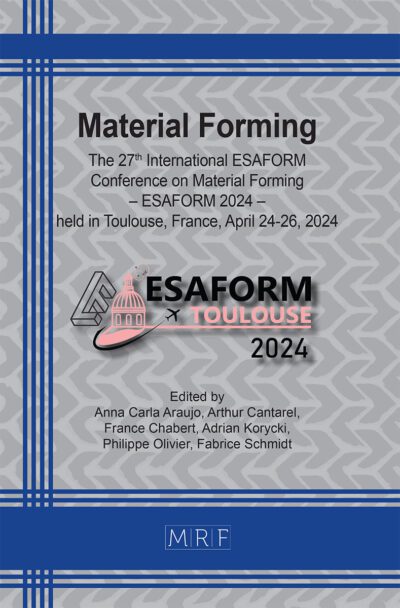A unified fracture model for cleavage and ductile fracture
Guijia Li, Zinan Li, Junhe Lian
Abstract. With increased plastic deformation strength, the body-centers cubic materials tend to switch from ductile fracture model to cleavage fracture, despite the increase caused by either intrinsic microstructure or alloy manipulation or extrinsic loading conditions, e.g., lowering temperatures. Due to the significant difference in failure mechanisms, current modeling approaches, either the fracture mechanics or damage mechanics-based models, treat them with separate and decoupled strategies. However, many recent developments in high-strength engineering materials or applications under extreme conditions encounter more often the meeting and interaction of these two fracture modes. This study, therefore, aims to propose a unified fracture model that is capable of predicting both ductile and cleavage fracture under a consistent mechanics framework and autonomously switching the models depending on the loading conditions. The model is calibrated and validated by high-strength bcc steels with tensile strength 1000 MPa and under quasi-static deformation at room temperature. The failure mechanisms are analyzed and confirmed by fractography and the microstructure features controlling the two fracture models are investigated by multiscale microstructure characterization. The developed model as well as the microstructure-property correlation eventually provides inspiration for formulating a meso-scale mechanism-based model to bridge with the mechanics-based model and also shed light on material design with tailored fracture resistance.
Keywords
Ductile Fracture, Cleavage Fracture, Fracture Modeling, Ductile-To-Brittle Transition
Published online 5/7/2025, 7 pages
Copyright © 2025 by the author(s)
Published under license by Materials Research Forum LLC., Millersville PA, USA
Citation: Guijia Li, Zinan Li, Junhe Lian, A unified fracture model for cleavage and ductile fracture, Materials Research Proceedings, Vol. 54, pp 1054-1060, 2025
DOI: https://doi.org/10.21741/9781644903599-114
The article was published as article 114 of the book Material Forming
![]() Content from this work may be used under the terms of the Creative Commons Attribution 3.0 license. Any further distribution of this work must maintain attribution to the author(s) and the title of the work, journal citation and DOI.
Content from this work may be used under the terms of the Creative Commons Attribution 3.0 license. Any further distribution of this work must maintain attribution to the author(s) and the title of the work, journal citation and DOI.
References
[1] F. Shen, S. Münstermann, and J. Lian, “A unified fracture criterion considering stress state dependent transition of failure mechanisms in bcc steels at –196 °C,” Int. J. Plast., vol. 156, p. 103365, Sep. 2022. https://doi.org/10.1016/j.ijplas.2022.103365
[2] H. Aydin, E. Essadiqi, I.-H. Jung, and S. Yue, “Development of 3rd generation AHSS with medium Mn content alloying compositions,” Mater. Sci. Eng. A, vol. 564, pp. 501–508, Mar. 2013. https://doi.org/10.1016/j.msea.2012.11.113
[3] C. Lesch, N. Kwiaton, and F. B. Klose, “Advanced High Strength Steels (AHSS) for Automotive Applications − Tailored Properties by Smart Microstructural Adjustments,” Steel Res. Int., vol. 88, no. 10, p. 1700210, 2017. https://doi.org/10.1002/srin.201700210
[4] J. G. Speer, A. M. Streicher, D. K. Matlock, F. Rizzo, and G. Krauss, “Quenching and Partitioning: A Fundamentally New Process to Create High Strength TRIP Sheet Microstructures”.
[5] I. de Diego-Calderón, I. Sabirov, J. M. Molina-Aldareguia, C. Föjer, R. Thiessen, and R. H. Petrov, “Microstructural design in quenched and partitioned (Q&P) steels to improve their fracture properties,” Mater. Sci. Eng. A, vol. 657, pp. 136–146, Mar. 2016. https://doi.org/10.1016/j.msea.2016.01.011
[6] L. Wang and J. G. Speer, “Quenching and Partitioning Steel Heat Treatment,” Metallogr. Microstruct. Anal., vol. 2, no. 4, pp. 268–281, Aug. 2013. https://doi.org/10.1007/s13632-013-0082-8
[7] K. Nahshon and J. W. Hutchinson, “Modification of the Gurson Model for shear failure,” Eur. J. Mech. – ASolids, vol. 27, no. 1, pp. 1–17, Jan. 2008. https://doi.org/10.1016/j.euromechsol.2007.08.002
[8] Y. Bai and T. Wierzbicki, “Application of extended Mohr–Coulomb criterion to ductile fracture,” Int. J. Fract., vol. 161, no. 1, pp. 1–20, Jan. 2010. https://doi.org/10.1007/s10704-009-9422-8
[9] D. Mohr and S. J. Marcadet, “Micromechanically-motivated phenomenological Hosford–Coulomb model for predicting ductile fracture initiation at low stress triaxialities,” Int. J. Solids Struct., vol. 67–68, pp. 40–55, Aug. 2015. https://doi.org/10.1016/j.ijsolstr.2015.02.024
[10] Y. Lou, H. Huh, S. Lim, and K. Pack, “New ductile fracture criterion for prediction of fracture forming limit diagrams of sheet metals,” Int. J. Solids Struct., vol. 49, no. 25, pp. 3605–3615, Dec. 2012. https://doi.org/10.1016/j.ijsolstr.2012.02.016
[11] C. Ruggieri and R. H. Dodds, “A local approach to cleavage fracture modeling: An overview of progress and challenges for engineering applications,” Eng. Fract. Mech., vol. 187, pp. 381–403, Jan. 2018. https://doi.org/10.1016/j.engfracmech.2017.12.021
[12] Z. Li et al., “Anisotropic fracture behavior of the 3rd generation advanced high-strength – Quenching and Partitioning steels: Experiments and simulation,” J. Mater. Res. Technol., vol. 30, pp. 9395–9414, May 2024. https://doi.org/10.1016/j.jmrt.2024.05.228
[13] Y. S. Lou and J. W. Yoon, “A Stress-Based Model for Shear Ductile Fracture,” Key Eng. Mater., vol. 794, pp. 3–8, Feb. 2019.
[14] Y. Lou, J. W. Yoon, H. Huh, Q. Chao, and J.-H. Song, “Correlation of the maximum shear stress with micro-mechanisms of ductile fracture for metals with high strength-to-weight ratio,” Int. J. Mech. Sci., vol. 146–147, pp. 583–601, Oct. 2018. https://doi.org/10.1016/j.ijmecsci.2018.03.025
[15] J. Lian et al., “An evolving non-associated Hill48 plasticity model accounting for anisotropic hardening and r-value evolution and its application to forming limit prediction,” Int. J. Solids Struct., vol. 151, pp. 20–44, Oct. 2018. https://doi.org/10.1016/j.ijsolstr.2017.04.007












